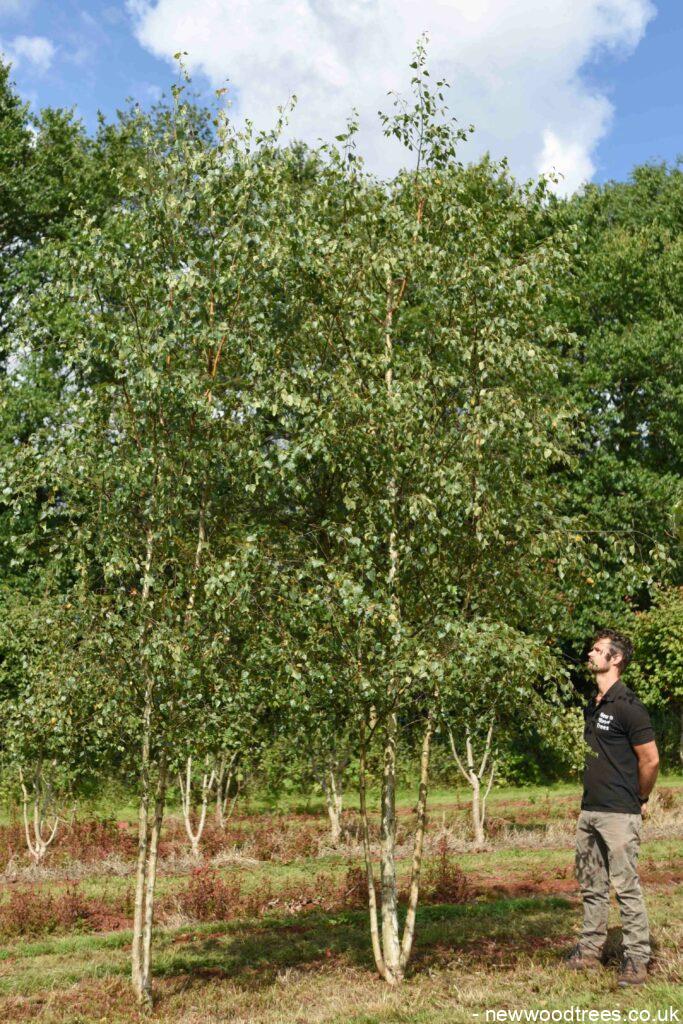Silver birch trees add four-season visual interest to landscapes with their striking white bark and graceful drooping branches. Some birch trees develop multiple stems from a shared root system rather than a single trunk. These multi-stem birches have a distinct look and growth pattern.
A common question is how tall multi-stem silver birch trees grow compared to traditional single-trunk varieties. Read on to learn about the mature height, growth rate, and developmental traits of multi-stem birch trees to determine if they fit your property.
(Unsure what we mean by ‘Multi-stem trees’? Check out our explainer here.)
Typical Height of Single Trunk Birch Trees
First, to understand how multi-stemmed tree height compares, let’s look at how tall single-stem birch trees get on average. Silver birch (Betula pendula) is a moderately fast-growing deciduous tree species. Given the right growing conditions, a single-trunk silver birch may grow 0.3-0.6 metres yearly, often more in the early years.
The typical mature height range is 12 to 21 metres for single-stem birch trees. Height varies based on specific cultivars. ‘Youngii’ is a dwarf birch reaching about 2.4 metres in maturity. Larger cultivars like ‘Laciniata’ grow to a towering 21 feet over time. On average, expect a mature height between 12-15 feet across varieties for a single-trunk birch tree.
Maximum Potential Height of Multi-Stem Silver Birch Trees
Multi-stem silver birch trees generally have a lower total height than single-stem birch trees. The individual trunks emerging from the same root system compete for shared resources. With the energy and nutrients divided among multiple stems, each stem’s growth rate and maximum size are marginally reduced.
The total height with all stems considered will usually be 9 to 12 metres for a mature multi-stem birch tree. While a single trunk may reach 15 metres, a multi-stem tree will likely max out at around 10 metres for the tallest point. The reduced height is offset by clustered stems’ wider, fuller shape. So, while size is lower, the total presence and volume can be striking.
Factors Affecting Growth Rate and Height
Several variables impact how tall single and multi-stem birch trees will grow. Genetics play a crucial role, with dwarf cultivars topping off much shorter than standard or large varieties. The nourishing qualities and moisture levels of the soil also affect development. Birch trees prefer slightly acidic, sandy soil with ample organic matter. More watering, especially in the early years, can also stunt growth. Proper planting depth, pruning practices, and general tree health further influence height potential. Consequently, actual dimensions can vary significantly within the typical range.
Growing Conditions for Optimal Height
Provide optimal growing conditions to encourage birches to reach their full height potential. This begins with site selection. Birch trees thrive in total sun exposure, ideally with at least 6 hours of direct sunlight daily. Ensure the soil drains well but also maintains good moisture. Add organic compost to planting beds to increase fertility. Give new trees regular deep watering for the first two years. Once established, birch trees are relatively drought resistant.
Avoid compacting root zones during landscaping and use mulch to retain moisture while suppressing weeds. Test the soil to determine if amendments are needed to balance pH levels. Fertilise minimally in early spring using formulations for deciduous trees. With ideal conditions, both single and multi-stem birch trees will flourish.
1. Rate of Growth of Multi-Stem Silver Birch Trees
In addition to height, birch trees are noted for their relatively fast growth rate. Under favourable conditions, silver birches may grow over 0.6 metres per year, especially when young. The speed of growth naturally slows over time as trees mature. For multi-stem varieties, the distribution of resources and energy to multiple stems instead of a central leader marginally reduces the per-stem rate of growth. However, this is balanced out by the collective development of all stems emerging from the root zone.
Despite their moderately fast growth pace, multi-stem birch trees maintain an attractive form over time without aggressive pruning needs. The tiered branching shape of the mature multi-stem habit retains a tidy appearance. Growth stays relatively compact, and the oval silhouette resists becoming gangly.
This makes multi-stem birch varieties ideal for smaller residential properties where rapid expansion could outgrow space. Their growth habit meshes well with surrounding ornamentals. With seasonal interest and graceful ageing, multi-stem birches blend beauty and practicality as landscape specimens.
2. Pruning for Height Control
Proper pruning techniques are key to managing birch tree height and shaping multi-stem varieties artfully. Wait to prune birches until they are established, usually 3-4 years after planting. To control height, prune the lead branch of a young birch tree by cutting it back by a third. For mature birches, thin inner branches allow airflow and light deeper into the canopy. Limit removing live branches to avoid compromising health. Shaping cuts should be made just above outward-facing buds. For multi-stem birches, remove only crossing or damaged stems. Strategic pruning stimulates optimal growth. (Pro tip: view our Top Tips For Pruning Tree Canopies).
Caring for Multi-Stem Birches
Caring for multi-stem silver birch trees differs little from single-stem varieties.
- Provide 2.5cms of water weekly and more during droughts.
- Fertilise in early spring using a balanced slow-release tree fertiliser.
- Prune out dead wood anytime but limit live branch removal.
- Clean up fallen leaves and twigs, which can spread disease.
- Inspect periodically for common birch pests like bronze birch borer.
- Contact an arborist for assistance if signs of borer damage emerge.
With attentive care, multi-stem birches have thrived for decades.
Whenever pruning multi-stem birch trees, sterilise equipment between cuts to prevent disease transmission. Make pruning cuts just above outward-facing buds to encourage optimal branch direction. Avoid removing more than 25% of live branches at a time to maintain vigour. Water thoroughly a day before more extensive pruning to minimise stress. Prune to enhance the elegance of the multi-stem form by removing awkward cross-crossing or congested branches.
Monitor for signs of bronze birch borer-like dieback starting at the top of stems and D-shaped exit holes. Apply preventative systemic insecticides if borers are detected. With vigilant care and protection, multi-stem birch trees will enhance the landscape for many years.
Structural Advantages of Multi-Stem Habit
The sturdy architecture of multi-stem birch trees also makes them suitable for properties needing privacy and screening against winds. Their dense, clustered branching structure forms a rugged living barricade when allowed to grow together. The intertwined stems are less likely to get bent by gusts than a solitary trunk. Multi-stem birches create an attractive sound barrier for properties along busy streets that muffles noise pollution.
An added benefit of the multi-stem growth habit is the exceptional structure it creates, which adds resilience. The interwoven stems emerging from the same root system create a sturdy, reinforced framework. Multiple stems reduce the risk of total splitting or breakage during harsh weather, making multi-stem birches less vulnerable to storm damage. The oval shape also helps shed heavy snow efficiently. These inherent structural advantages make multi-stem varieties ideal for high-wind and heavy snowfall regions.
Their density diffuses and absorbs passing traffic noise. The reinforced yet flexible frame of multi-stem birches handles weight, forces, and stress, making them resilient landscape additions.
Ideal Uses for Multi-Stem Silver Birch Trees in Landscape Design
When used thoughtfully in design plans, multi-stem birch trees shine. Their relatively compact size suits residential yards nicely compared to bigger single-trunk birches. The layered horizontal form creates charging patterns when underplanted with lower-growing perennials, bulbs, and ground cover. They look stately, flanking entries or lining driveways. Their brightness adds luminescence to shady plots.
Clustering groups of multi-stem birches make a dramatic collective statement. They fill narrow spaces well. The striking bark provides winter interest and pops against evergreens. Incorporating multi-stem varieties along with single-trunk birches adds diverse textures.
Though more petite, their beautiful multi-stem form still captures attention.
Selecting Appropriate Species and Cultivars
Several birch species and cultivars display the multi-stem growth tendency naturally. Paper birch (Betula papyrifera) frequently develops multiple stems. The ‘Renci’ paper birch cultivar is prized for its reliable multi-stem form. Some river birch (Betula nigra) varieties like ‘Little King’ sprout clusters of trunks. A widely available multi-stem birch is Betula populifolia, the grey birch species.
For the coveted white bark, choose multi-stem varieties of Betula pendula like ‘Silverspire,’ which grows tighter clumps. Be aware specific species and cultivars have different ultimate sizes, so select based on available space. Consult with nurseries to pick suitable types for your needs from among the many multi-stem birch options.
Caring for Existing Multi-Stem Birches
Some single-trunk birch trees may occasionally sprout multiple trunks spontaneously due to stresses like damage, disease, or improper pruning. Providing supplemental irrigation and fertiliser around the root zones of distressed trees can encourage recovery and return to dominant single-stem growth. For mature multi-stem birches, you can maintain their health and vigour with a little attentive care.
Remove any competing underbrush regularly and control the disease. Thin congested branches but avoid removing more than 25% of living limbs. Keep surrounding grass and plants a distance from the root system. Continue fertilising, pruning, and promptly treating any pathogens or pests.
Conclusion
The unique multi-stem growth form of certain silver birch trees contributes ornamental qualities while influencing their developmental pattern. Though individual stem height may reach just 30-40 feet at maturity, the collective oval form creates a substantial presence. By understanding multi-stem birch traits, growth needs, and care, those cultivating birches can encourage success.
With their captivating shape, multi-season appeal, and graceful movement, multi-stem birch trees are prized options where space permits. Give them room to showcase their distinctive structure, and they will flourish as cherished landscape specimens.







